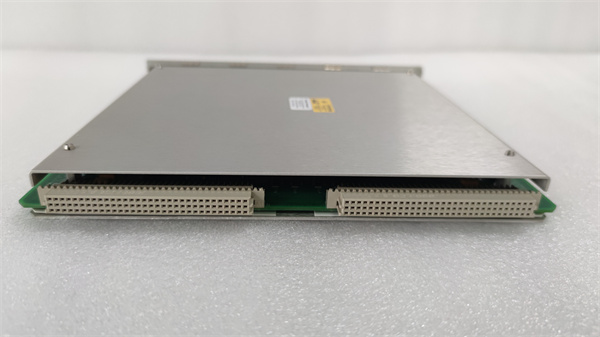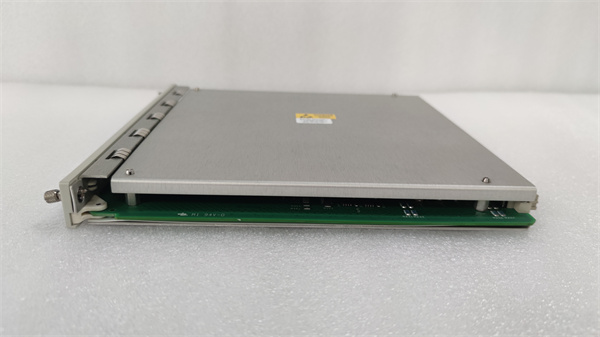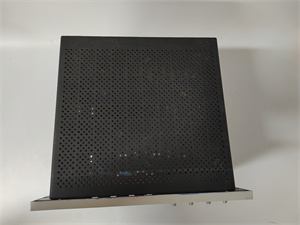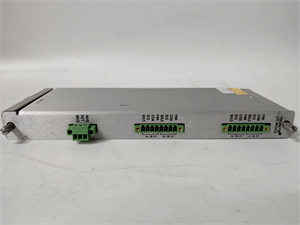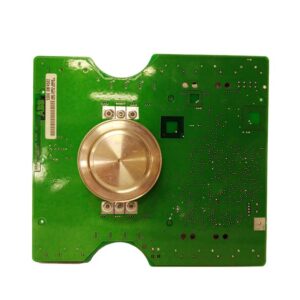Description
Detailed parameter table
| Parameter name | Parameter value |
| Product model | 3500/33-01-02 149986-01 |
| Manufacturer | BENTLY NEVADA |
| Product category | Vibration monitor module |
| Electrical performance | 24V DC power supply; 8-channel input; 4-20mA output per channel; Power consumption: 10.5W max |
| Physical size | Width: 24.4mm, Height: 241.3mm, Depth: 242mm |
| Interface type | BNC connectors for vibration sensor inputs; Terminal blocks for power and analog outputs; Backplane connector for system communication |
| Communication protocol | Integrates with 3500 series system bus; Supports analog output for DCS/SCADA integration; Enhanced with digital communication via module backplane |
| Environmental requirements | Operating temperature: -40°C to +70°C; Humidity: 5% – 95%, non-condensing; Vibration resistance: 10g peak (10-2000Hz) |
| Installation method | Rack-mountable in 3500 series racks; Occupies 1 standard slot |
| Performance indicators | Measurement range: 0-50mm/s RMS (expandable to 0-100mm/s RMS with configuration); Accuracy: ±0.8% of reading; Frequency response: 5Hz – 1kHz; Sampling rate: 10kHz per channel |
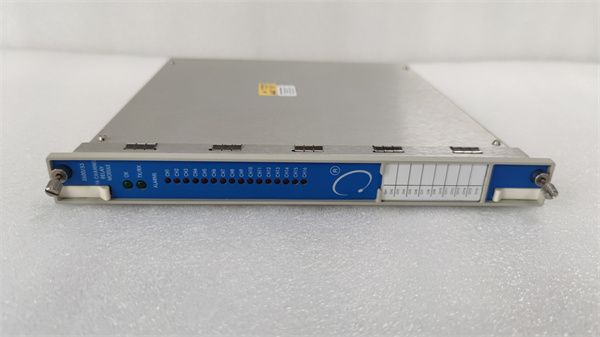
BENTLY 3500/33-01-02 149986-01
Product introduction
The BENTLY NEVADA 3500/33-01-02 149986-01 is an advanced 8-channel vibration monitor module, an upgraded variant within the 3500 series machinery protection system. It is engineered to deliver enhanced vibration monitoring capabilities for rotating machinery in demanding industrial environments, serving as a critical component in predictive maintenance and machinery protection strategies.
This module builds on the foundation of its predecessor by processing signals from a broader range of sensors, including accelerometers, velocity sensors, and proximity transducers. It converts raw vibration data into precise measurements such as overall vibration amplitude, peak-to-peak values, and filtered vibration components. The 3500/33-01-02 149986-01 not only provides standardized 4-20mA outputs for each channel but also features improved digital communication capabilities, enabling seamless integration with control systems and data analytics platforms. In automation architectures, it acts as a high-performance hub for vibration data, detecting early signs of machinery issues like bearing degradation, rotor imbalance, and misalignment to prevent unplanned downtime.
Core advantages and technical highlights
Enhanced measurement capabilities: The 3500/33-01-02 149986-01 offers an expanded measurement range, with the ability to monitor up to 100mm/s RMS when configured, making it suitable for high-amplitude vibration scenarios such as in heavy-duty crushers or large industrial fans. Its improved accuracy of ±0.8% of reading ensures reliable data even in the most critical applications, where precise vibration monitoring is essential for machinery health assessment.
Extended frequency response: With a frequency response range of 5Hz – 1kHz, this module captures lower-frequency vibrations that may indicate foundational issues in machinery, such as resonance or structural looseness. This extended range, combined with a 10kHz per channel sampling rate, ensures that both transient and steady-state vibration events are accurately recorded, providing a more comprehensive picture of machinery performance.
Advanced signal filtering: The module incorporates enhanced digital filtering algorithms that effectively isolate specific vibration frequencies, reducing the impact of background noise and interference. This is particularly valuable in complex industrial environments with multiple machinery units, where cross-interference can corrupt vibration signals. The advanced filtering ensures that only relevant vibration data is processed and transmitted, improving the accuracy of fault detection.
Improved diagnostic features: The 3500/33-01-02 149986-01 comes equipped with enhanced diagnostic capabilities, including self-monitoring of internal components and sensor connectivity. It can detect issues such as sensor cable faults, short circuits, or open circuits, providing timely alerts to maintenance teams. This proactive diagnostic functionality reduces troubleshooting time and ensures that the monitoring system itself remains reliable.
Typical application scenarios
In mining operations, the 3500/33-01-02 149986-01 is used to monitor large crushers and grinding mills. These machines operate under extreme conditions with high vibration amplitudes, and the module’s expanded measurement range (up to 100mm/s RMS) allows for accurate monitoring of their performance. By tracking vibration patterns, it can detect issues like bearing wear in the mill’s drive system or imbalance in the crusher’s rotor, enabling maintenance to be scheduled before catastrophic failures occur.
Within chemical processing plants, the module monitors centrifugal pumps and agitators handling corrosive or viscous materials. Its extended frequency response captures low-frequency vibrations that may indicate cavitation in pumps or gear meshing issues in agitator drives. The advanced filtering capabilities ensure that vibration data remains accurate even in the electrically noisy environment of chemical plants, where motors and other equipment generate significant interference.
In renewable energy facilities, such as wind farms, the 3500/33-01-02 149986-01 monitors the vibration of wind turbine gearboxes and generators. Operating in harsh outdoor environments, the module’s rugged design withstands temperature extremes and humidity, ensuring reliable operation. By detecting early signs of gear wear or generator bearing degradation, it helps maximize the uptime of wind turbines, which are critical for energy production.

BENTLY 3500/33-01-02 149986-01
Related model recommendations
3500/33-01-00 149986-01: The base model of the 8-channel vibration monitor, which the 3500/33-01-02 149986-01 upgrades. It is suitable for standard vibration monitoring applications where the enhanced features of the newer model are not required.
330730-080-00-00: A high-sensitivity accelerometer perfectly paired with the 3500/33-01-02 149986-01, providing high-quality vibration signals for accurate measurement across the module’s extended frequency range.
3500/92-04-01-00 136180-01: A communication gateway that leverages the enhanced digital capabilities of the 3500/33-01-02 149986-01 to transmit vibration data to Ethernet-based systems, enabling advanced data analytics and remote monitoring.
3500/15 106M1079-01: A reliable power supply module that provides stable 24V DC power to the 3500/33-01-02 149986-01, ensuring consistent performance even in power-constrained environments.
149992-01: A shielded BNC cable assembly with improved noise reduction properties, used to connect vibration sensors to the 3500/33-01-02 149986-01, preserving signal integrity in highly noisy industrial environments.
3500/55: A display and keypad module that allows for local configuration and monitoring of the 3500/33-01-02 149986-01, providing operators with real-time access to vibration data and alarm status.
3500/20: An advanced rack interface module that facilitates seamless communication between the 3500/33-01-02 149986-01 and other modules in the 3500 rack, enhancing system integration and data sharing.
Installation, commissioning and maintenance instructions
Installation preparation: Before installing the 3500/33-01-02 149986-01, power off the 3500 rack and verify proper grounding. Ensure the installation environment meets the specified temperature and humidity ranges. Required tools include a torque wrench (set to 0.5-0.7Nm), Phillips screwdriver, and anti-static wrist strap. Inspect the module for physical damage and clean BNC connectors with isopropyl alcohol. Align the module with the rack guides and gently insert until the backplane connector fully engages, then secure with mounting screws.
Commissioning: After installation, power on the 3500 series rack and use the latest version of BENTLY NEVADA’s configuration software to set up the module. Configure the measurement range, frequency filters, and alarm thresholds for each channel according to the specific machinery requirements. Perform a calibration check using a reference vibration source to verify accuracy. Test communication with connected systems via both analog outputs and digital backplane to ensure data is transmitted correctly. Check the LED indicators; a steady green “OK” light indicates normal operation, while blinking lights signal active alarms or communication activity.
Maintenance suggestions: Perform bi-monthly visual inspections of the 3500/33-01-02 149986-01 to check for loose connections, dust accumulation, or signs of overheating. Clean the module surface with a dry, lint-free cloth. Calibrate semi-annually using BENTLY NEVADA’s advanced calibration kit to maintain ±0.8% accuracy. If erratic readings occur, use the module’s diagnostic features to check for sensor faults or cable issues—replace damaged 149992-01 cables with genuine parts. For fault codes, refer to the enhanced diagnostic logs accessible via the 3500 system software. Keep a detailed maintenance log documenting calibrations, alarm events, and repairs to track module performance over time.
Service and guarantee commitment
The 3500/33-01-02 149986-01 comes with a 15-month warranty covering manufacturing defects, an extension over standard models. During this period, we provide free repair or replacement for faulty units. Our technical support team offers 24/7 assistance for installation, configuration, and troubleshooting via phone, email, and online chat, with priority response for this advanced module. We supply comprehensive documentation, including enhanced calibration procedures and integration guides tailored to its advanced features.
For critical applications, optional extended warranties (up to 5 years) are available, including on-site support, annual preventive maintenance checks, and software updates. Backed by BENTLY NEVADA’s extensive experience in machinery protection, the 3500/33-01-02 149986-01 is guaranteed to deliver reliable, high-performance vibration monitoring, helping you maintain machinery health and maximize production uptime in even the most challenging industrial environments.

